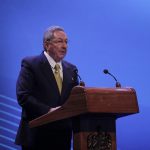In late 1961 and early 1962, and led by the head of the Revolutionary Guidance Commission, first of the Integrated Revolutionary Organizations, and after the United Party of the Socialist Revolution, Cesar Escalante Dellundé, steps were taken to the institutionalization, which culminated in the signing of Law 1 030, which validated the creation of the Cuban Institute of Broadcasting, on May 24, 1962. In 1975 the name underwent a change and became known as the Cuban Radio and Television Institute (ICRT), with the same attributions.
Radio
The first station that transmitted in Cuba was the 2LC of Luis Casas Romero, on August 22, 1922. October 10, 1922, first transmission of the PWX, is officially considered like the inauguration of the broadcasting in Cuba, the inaugural speech of the then President of the Republic Alfredo Zayas was broadcasted, in Spanish and English for the American people. Since its beginnings until the decade of the thirty the radio maintained a programming based fundamentally in the information and the entertainment. On February 24, 1959, Radio Rebelde, station of the Revolution broadcasted from the Sierra Maestra. By the end of 1959 there were 156 radio repeaters in the country. With the triumph of the Revolution in 1959, changes in the radio take place. In 1960, the Free Broadcasters Front (FIEL) was created, which provided the Cuban State with the facilities and operation of its services. On May 1, 1961 the International radio station Radio Habana Cuba was inaugurated. After the revolutionary triumph the state has worked so that the radio signal could be captured throughout the national territory and reflects the socioeconomic development, with a network of national, provincial, municipal and local broadcasters that make up the Cuban Radio Subsystem. The National Radio Network has 69 radio stations and 82 municipal studios distributed throughout the country.
TV
During the first half of the 1940s in the 20th century, several commercial television channels were inaugurated in the USA. A fact that very soon had repercussions in Cuba for the existence of a strong, vast and successful radio system with commercial objectives, which even reached an incipient concentration of stations in which they would later be important national multimedia groups, also boosted by the excellent relations between the US electronic signatures and the main executives and radios companies located in Havana, reflecting the intimate political relationship from the Government itself.
Paradoxically, chance wanted the first demonstration of television in our country to be carried out by a Cuban marriage, independently of the entire structure of existing radio power, who became, without thinking, sponsors and protagonists of this historical event. The story began for them when traveling to New York for their honeymoon. There they were dazzled by this invention and made the decision to take the first steps with executives of American television stations, to develop a television exhibition in Havana.
On October 24, 1950, the first television channel was officially inaugurated, which established regular television transmission operations in Cuba. With this, our country, along with Mexico and Brazil in the same quarter of 1950, integrated the founding trilogy. On October 12, the test transmission period began with fixed views and interviews that were held until the inauguration day at the Presidential Palace (now the Museum of the Revolution). The ceremony was transmitted by a mobile remote control unit that sent the signal to the plant and from there to the TV receivers already existing in the city of Havana. The first televising programs were the Baseball games from the Cerro’s Stadium and the shows carried out from the rented theaters that were conjugated with a reduced number of programs of the musical, humoristic and commercial wedges genres produced in sets. Thanks to this operative solution that broke the traditional molds in TV, the support of the programming of Channel 4 was solved, in its first stage of transmission.
After creating our television system (since 1960 for public service purposes and in terms of culture, education, training and information for the whole society), Televisión Cubana currently has four national channels (two of them specialized in educational topics), 15 territorial tele centers (in all provinces and the special Municipality of Isla de la Juventud), an international signal Cuba vision International (www.cubavision.cubaweb.cu) and TV Serrana a community video producer based in the Sierra Maestra east of country. It is born as an important option Multivision, which covers more than 50 percent of the national territory.

Redacción Digital
Equipo de redactores del sitio web de Radio Mayabeque


